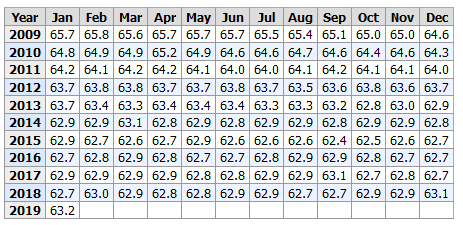Yesterday CNS News posted an article about the January Workforce Participation Rate. This is the number of people in America either working or looking for jobs. When President Obama took office in January 2009, the Workforce Participation Rate was 65.7. That number dropped to a low of 62.4 in September 2015 and began slowly climbing, reaching a high of 62.9 in September 2016. The number hovered around there for a while until finally reaching 63.2 in January 2019.
Here is the chart from the Bureau of Labor Statistics:
 The article at CNS News reports:
The article at CNS News reports:
The Labor Department’s Bureau of Labor Statistics said the economy added 304,000 jobs last month, higher than analysts were expecting.
The number of employed Americans, 156,694,000, was slightly below last month’s record (156,945,000), and the unemployment rate increased a tenth of a point to 4.0 percent.
But the labor force participation rate increased a tenth of a point to 63.2 percent — the highest it’s been on President Trump’s watch.
The CNS News article included an excerpt from the Congressional Budget Report released this week:
According to CBO:
Employment: Nonfarm payroll employment is projected to grow by an average of 148,000 jobs per month in 2019, a decline from 213,000 jobs/month in 2018 but “still a healthy pace of job growth at this stage of the business cycle.”
Unemployment rate: The unemployment rate, now at its lowest point since the 1960s, is projected to fall from 3.8 percent in the fourth quarter of 2018 to 3.5 percent by the end of 2019. The anticipated decline in the unemployment rate reflects a continued increase in the demand for labor, which will reduce the number of unemployed workers in the labor force this year.
CBO said the demand for labor and the resulting upward pressure on compensation also encourages people to remain in the labor force or rejoin it, making the labor force larger and thus moderating the decline in the unemployment rate.
Labor force participation: The labor force participation rate, which has hovered around 62.8 percent since 2014, is expected to remain close to that rate during the next two years.
CBO explained that the stability of the labor force participation rate in recent years reflects the balancing of two opposing forces: sustained economic growth, which continues to encourage additional workers to enter the labor force and currently employed workers to stay on the job; and long-run shifts in demographics (particularly the aging of the population).
Labor compensation. After several years of prolonged weakness, wage growth accelerated notably in 2018, CBO noted. Over the next few years, labor compensation is expected to rise further as employment remains at elevated levels and firms must compete for a relatively small pool of unemployed or underemployed workers.
In CBO’s projections, annual growth of the employment cost index for wages and salaries of workers in private industry averages 3.5 percent between 2019 and 2023, slightly more rapid than its 3.3 percent pace in 2018 and considerably more rapid than the 2.0 percent average from 2009 to 2017.
President Trump’s economic policies are working. If he is allowed to continue those policies with a Democrat House of Representatives, he will be re-elected in 2020, so prepare to see the House of Representatives attempt to roll back many of those policies.
